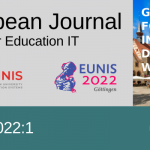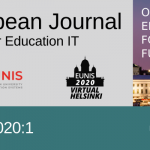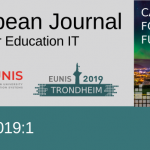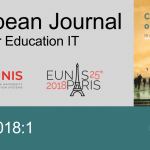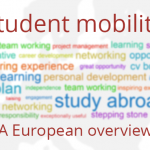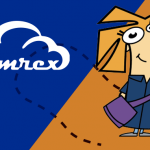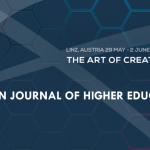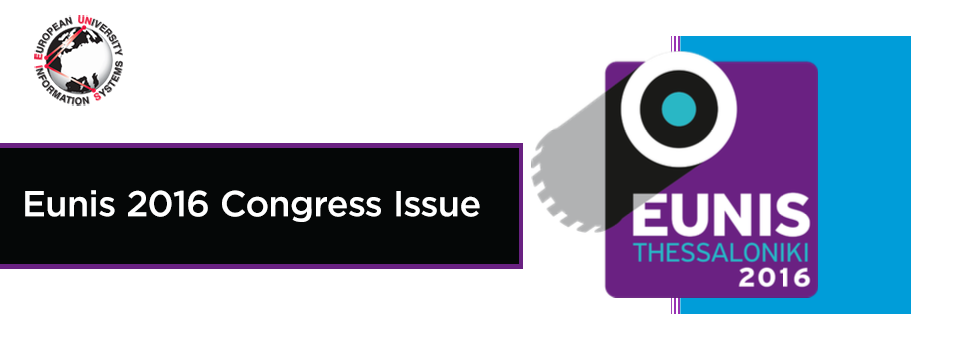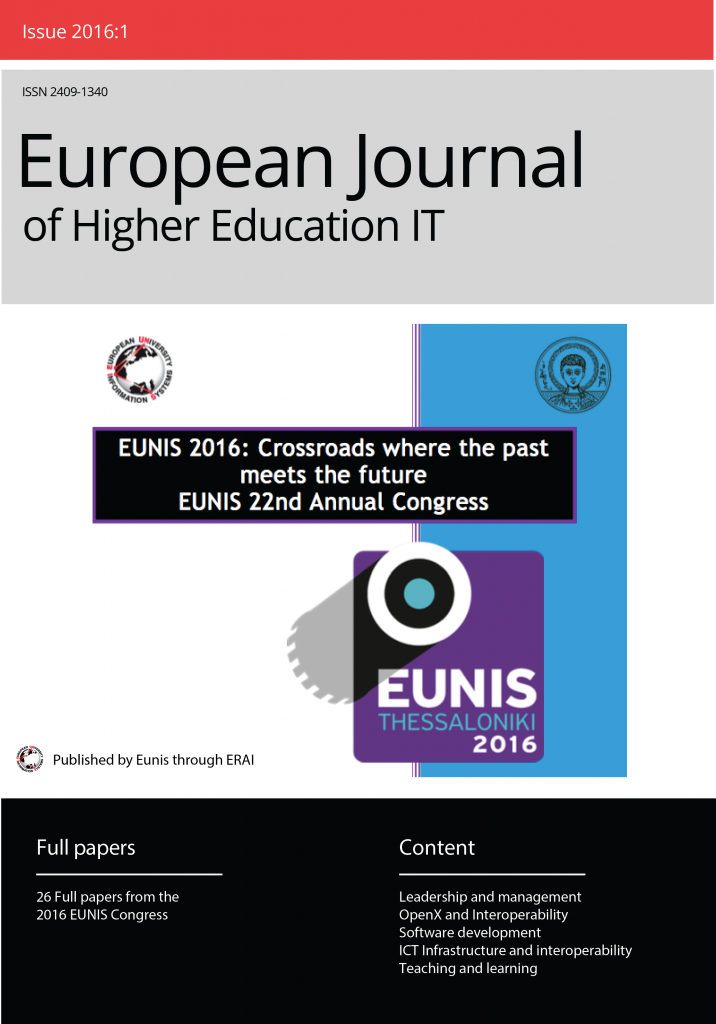
Reference to articles in this issue should be made as follows:
name of author(s). title, European Journal of Higher Education IT 2016/1
Book of abstracts
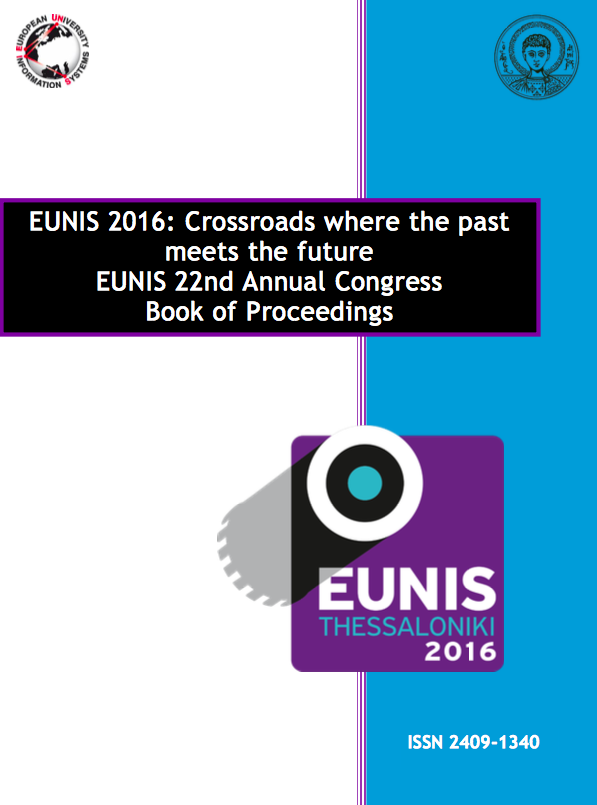
European Journal of Higher Education IT – EJHEIT
This issue of the European Journal of Higher Education IT (2016/1) consists of the full papers from the EUNIS 2016 congress.
In total, 27 full papers were submitted to the congress. In this issue there is a focus on the tracks Management and governance and Corporate Information Systems and Business applications, Information and communications technology, Teaching and Learning
European Journal of Higher Education IT is a journal created to support the mission of EUNIS and to disseminate International Research within the field of higher education IT. Editorial Committee
ISSN 2519-1764
Leadership and management
Central IT Organizations and How They Support Research in the U.S
Gregory Palmer
Abstract
Central IT Organizations and How They Support Research in the U.S
Since information technology became a centralized function at universities in the U.S. the primary role was considered to be focused on communications and administrative computing. The IT needs of the research communities were generally considered too specialized for the campus-wide organization and fulfilling the hardware, software, storage, and computing requirements became the responsibility of the individual researcher, their department, or the specific faculty. Recently, however, Presidents, Provosts, and Research Deans have given the direction to their Chief Information Officers that they must provide more centralized support for those conducting research while creating economies of scale, (lower costs) across the entire university. The demand for advanced on-campus data centers, high performance computing and networking, and the skilled labor necessary to operate research intensive computing and analytic software has been a great challenge to central IT organizations. It becomes even more difficult when the outcomes are expected to be more cost effective than the current distributed methods. This paper is the result of extensive interviews with eight universities classified as “research intensive”. It analyzes the objective and subjective components of the strategic plans of the central IT administrators, and concludes with financial and operational recommendations taken from the successful models.
State of Enterprise Architecture practice in Finnish Higher Education sector
Nestori Syynimaa, Patrik Maltusch, Esa Suominen
Abstract
State of Enterprise Architecture practice in Finnish Higher Education sector
Enterprise Architecture (EA) has been practiced in Finnish Higher Education (HE) sector for several years. In 2011 the Finnish parliament ratified an act mandating all public sector organisation to adopt EA by 2014. Despite the Act, several studies have shown that the maturity of EA is low in Finnish public sector. To support the development of EA practice in Finnish HE sector, an EA Special Interest Group (EA-SIG) was founded in 2012. To shed light to the current state of the EA practice in Finnish HE sector, this paper reports the findings from a recent EA maturity study conducted by EA-SIG. The findings indicate that currently only half of the Finnish HE institutions have achieved the “defined” level of EA maturity. According to the study, the other half will achieve this level in two years.
The social university: delivering business benefit through online networking
Dr. Gill Ferrell, Anna Mathews
Abstract
The social university: delivering business benefit through online networking
This paper encourages senior management teams to adopt a strategic approach to university use of social media.
Social media tools have a user base of millions and are increasingly used by universities but often in an ad hoc fashion. There are examples of good use of social media for business activities including student recruitment, induction, learning and teaching, research, delivering IT customer service, alumni relations and other areas.
However, universities have not yet been able to embed pockets of good practice into more strategic approaches that meet particular needs. Many have been swept along by a global trend without being clear what they want to achieve using social media. There are more HE courses on developing a social media strategy than there are university social media strategies!
The time is right to be more visionary in approach and more tactical in the use of particular tools. Senior management teams need understanding of the opportunities and risks to provide leadership and ensure this type of engagement delivers the desired benefits.
A strategic approach doesn’t mean your university’s social presence will become bland and corporate
but rather that you can use new tools to enhance the core activities of a scholarly community.
The Future of IT Management: A Longitudinal Qualitative Review
Noel Wilson, Johan Bergström
Abstract
The Future of IT Management: A Longitudinal Qualitative Review
This paper is a sequel to the 2015 paper “EUNIS Congress’ 21st Birthday: A Historical Perspective on its Proceedings ”. Its focus is on IT management activities as interpreted from information available in the “EUNIS Proceedings repository”. Papers on non-technical aspects of IT management are a small percentage of those presented over the Congress’ 21 year history; they fall under several tracks, however by “drilling down” into abstracts and keywords an indication of “hot to pics” is possible.
IT management foci have seen paradigm shifts from emphasis on operational and service management through customer relations and st rategic management, then governance and ‘top table’ participation.
Technological advances are impacting significantly upon society, with the pace of change being rampant. With the socialization of IT and the personalization of “smart” devices are we confronting a future where current IT management emphasis needs to change in terms of an ability to keep pace with an agile environment? What skills are necessary if IT leadership is to be in tune with institutional requirements and capable of delivery so as to maintain competitive advantages? Is the successivereliance on conventional management practices agile enough in the present time? Are we at acrossroads where present management emphasis is at variance with a need to be an innovative leader identifying and devising technology-rich environments that are abreast of our student generation?
Some challenges and approaches to them are outlined in response to these questions, calling upon
research elsewhere in the Higher Education (HE) sector and in business literature.
OpenX and Interoperability
Erasmus Without Paper — from the technical perspective
Janina Mincer-Daszkiewicz, Wojciech Rygielski
Abstract
Erasmus Without Paper — from the technical perspective
The Erasmus Without Paper (EWP) project [2, 3] aims to create a network supporting the electronic exchange of student data by interlinking the existing Erasmus student databases of Higher Education Institutions (HEIs) with the goal to permanently migrate from the paper world to the electronic world of student data. It is a response to the current needs of the information society, more specifically a large number of potential end-beneficiaries ranging from students, institutional Erasmus coordinators, IRO staff, HEIs at large, national agencies, or even the European Commission. The project addresses the Erasmus+ goal of increasing student mobility and recognition of student achievements (measured in recognized ECTS points). The EWP Network is the first attempt to standardize student data transfer on a European-wide scale. It is important to note that the transfer does not involve documents themselves (e.g. scanned copies) but the data that is contained in these documents, so that they can be used for the generation of various documents, processed automatically and stored in institutional databases. In particular, no data is held centrally.
There are 11 partners composed of public institutions, higher education organizations, and companies from 8 European countries with a dissemination potential to over 400 HEIs from 36 European countries. They are supported by 11 associate partners actively involved in the project.
The project started on November 1st, 2015 and will last for two years (grant number 562264-EPP-1-2015-1-BE-EPPKA3-PI-FORWARD).
In this paper we present the results of the first half year of the project, mostly from the technical perspective. We want to share some design and implementation decisions concerning the architecture, security, scalability of the EWP Network, data format, API, protocols supporting data exchange, and other technically oriented issues.
EMREX in Poland supporting internal mobility
Janina Mincer-Daszkiewicz, Wojciech Rygielski
Abstract
EMREX in Poland supporting internal mobility
EMREX [1, 3] is the ERASMUS+ Key Action 3 project (grant number 388499-EPP-1-2014-2-FI-EPPKA3-PI-POLICY) which aims at building a platform for an effective transfer of mobile students’ achievements between partner institutions and thus promoting higher attainment level to student mobility in higher education. Five countries, Finland, Norway, Sweden, Denmark and Italy, agreed to add student mobility plug-ins (SMP) to local student information systems (SIS), set up national contact points (NCP) at country-level through which partner institutions may get access to data on student achievements, and run field trial. Poland is the evaluation body which is responsible in the project for the evaluation of the impact of the EMREX platform on the student mobility and the quality and scalability of the solution from the technical perspective.
To avoid legal issues of data privacy, the partners in the project decided that in EMREX data transfer will be initiated by data owners, i.e. mobile students. Student will log in to SIS of home institution, with help of SMP be directed to the NCP of the country of the host institution, be authorized by the SIS of the host institution, and trigger transfer of achievements.
The EMREX platform seems to solve a well recognized problem in a simple and elegant way. Development of the software components needed to join the network does not seem like a difficult task. The designed solution looks attractive from the perspective of the main stakeholders, mobile students and university administration.
Poland has a rich program of internal mobility, called MOST (Polish word for bridge), see [5]. In academic year 2015/2016, 534 students from 28 higher education institutions (HEI) spend semester or two in other Polish HEI. 15 of these institutions belong to MUCI consortium [6] and use the same SIS, called University Study-Oriented System (USOS, [7]). If the Polish partner integrates USOS with the EMREX platform mobile students from these institutions will be able to easily transfer their transcripts of records from USOS installation at host institution to USOS installation at home institution. The effect of scale will be immediate. If the system proves useful internally, going international will be an easy next step.
In the paper we describe EMREX solution for Poland internal mobility from the technical and organizational perspective.
Eunis Elite award winner
Interoperability between Information Systems of Portuguese Higher Education Institutions
Lígia M. Ribeiro, Rui H. Pereira, Osvaldo Pacheco, Mário Bernardes, Ricardo T. Martins
Abstract
Interoperability between Information Systems of Portuguese Higher Education Institutions
The main thrust of this work is to present an interoperability platform between information systems of higher education institutions in Portugal and the main advantages and benefits its use has already allowed within an academic community of about 100,000 users. This interoperability platform, running on a cloud computing environment, was a major result of a project called “IES+Perto”, meaning “Higher Education Institutions Closer”, involving some of the most prestigious Portuguese universities and the largest polytechnic in the country. It was developed with a unifying but not intrusive perspective, so that each institution would continue to be solely responsible for the organization and delivery of its information.
A common mobility strategy for digital content supported by an application for mobile devices, and a set of services for electronic data transfer between institutions for the academic processes of student national mobility and joint courses of study, have been developed using the interoperability platform.
The project IES+Perto and the interoperability platform in particular have contributed very positively to innovation, administrative modernization and electronic management of the institutions involved, creating conditions for the extension of services to other higher education institutions, as has already happened by supporting new initiatives that the project IES+Perto proponents and other
higher education institutions submitted for funding under a new application to the National
Administrative Modernization Support System, which were approved.
How Do Researchers Manage their Data? An Empirical Comparison between Policies and Practice
Anne Thoring, Dominik Rudolph, Raimund Vogl
Abstract
How Do Researchers Manage their Data? An Empirical Comparison between Policies and Practice
Several academic organizations like the German Research Foundation (DFG) increasingly emphasize the importance of a professional research data management for the scientific community. Regulations for secure storage and making data available in terms of open science need to be established, to fully harness the immense value of research data as a proof of accuracy and as a basis for future studies. With 667 completed questionnaires by researchers at Münster University (WWU), this survey aims to provide insights on the implementation of research data management in research practice generally and in different academic disciplines in particular.
An Integral Approach to Support Research Data Management at the Humboldt-Universität zu Berlin
Malte Dreyer, Andreas Vollmer
Abstract
An Integral Approach to Support Research Data Management at the Humboldt-Universität zu Berlin
To address the increasing requirements on research data management, the Humboldt-Universität zu Berlin (HU) developed and established an integrated approach to provide research data support and services to scholars, students and administrative staff. This paper will discuss the type of requirements from external stakeholders, as well as the needs expressed and identified from within the HU. The derived concept will be explained in detail and examples for specific activities will be given.
Software development
Deploying an University App Store with Open Innovation
Jaime Busquets, Miguel Macías, Raúl Mengod, Juan Evangelista, Carlos Turro
Abstract
Deploying an University App Store with Open Innovation
The usual practice of universities when deploying corporate apps for mobile devices is to have it in the official stores of the most common systems and grow it by the addition of services like a corporate webpage. This behavior fails in the sense that don’t address both the ways that mobile user consume services and also because calls for a centralized IT service managing all the web app.
The Open Innovation paradigm allows involving internal and external users in the definition and creation of services. The new Strategic Plan for 2015-2020 of the UPV states the “Open Innovation” paradigm as a strategic project for that period. The vision of that strategic project is to develop a methodology of innovative projects that can help a radical improvement of the organization.
As a first action, UPV has a pilot project in order to implement a corporate mobile ecosystem, including a corporate App Store and develop applications through a development framework that offer users agile alternatives to perform common functions.
Benefits of this project are increased service, improving the user experience, and also security and confidence that are and inherent risk in traditional stores. UPV App Store is presented to the users in mid- March 2016 containing a dozen downloadable applications.
New university ERP for studying, teaching and administration – past, present and the future of the Peppi
Tuomas Orama, Jaakko Rannila, Mika Lavikainen, Lauri Stigell
Abstract
New university ERP for studying, teaching and administration – past, present and the future of the Peppi
It has been over a decade in Finland since the latest new Higher Education Institution (HEI) student information system (SIS) was released. At the moment, there is more or less only two prevailing ecosystems in Finland. Those two are Oodi in universities and Winha in universities of applied sciences (MINEDU 2016). Both of them are made in the late 90’s.
HEI’s woke up into the situation of renewing ecosystems in 2005 when ProAMK (PROAMK 2007) project was started. Its goal was set high ‐ to create one ecosystem for every university of applied sciences in the areas of education and research. In 2007, the project was closed down because of lack of belief and courage. In 2009 new project started by the ministry of education. It was called RAKETTI and one of its goals was to create or acquire a new student information system for the whole sector. In 2010 the project excluded that goal from the project ‐ because of lack of belief and courage. Instead, the project refocused on the architectural specifications, definitions of definite national services and some reference projects (RAKETTI 2014).
Gradually the understanding was reached which process areas would be covered by national solutions (student admission, application procedure) and which by the HEI’s themselves.
LARK: Location-Aware Personalized Travel Guide with Rich Knowledge
Spyridon Bontomitsidis, Dimitrios Floros, Dimitrios Manolas, Konstantinos Mylonakis, Nikos Pitsianis
Abstract
LARK: Location-Aware Personalized Travel Guide with Rich Knowledge
We present LARK, a mobile web application at edu.lark.gr, that provides location-aware information content. LARK is a query-search-optimization engine that serves as a multimedia database, an individually customized tour planner and an on-site tour guide. Technically, LARK consists of a server component to facilitate generation, modification, search of multimedia content that can be related, and adaptive, to physical locations and a mobile app to render and adapt the tours on user’s mobile device(s) and interests. LARK provides new possibilities for collecting and sharing specialized knowledge beyond tourism, by presenting tours with high educational and historical significance for its users.
Engaging students in building better digital services
Pauliina Kupila, Ulla Lehtonen
Abstract
Engaging students in building better digital services
University students use a number of Social Network Sites (SNS) in their everyday life (Usuel et al. 2009). For example Facebook and WhatsApp are used to create own circles and groups to help in connecting with other students. The University of Helsinki does not recommend educational use of Facebook since we cannot require the students to sign up for user accounts in SNSs.
The Digital Teaching and Learning Environment project of the University of Helsinki develops new teaching and learning services in order to create a uniform and user-friendly learning environment. The services are developed using the agile approach and with the attitude “mobile first”. Both teachers and students are engaged in planning and testing of the services.
As a new way to catch ideas and feedback from students we have invited students to participate in a Student Panel, which meets about three times a semester. The incentive to participate in the panel is the chance to influence on the planning of new digital services. The panel members will serve as early adopters of our services.
Before launching the Student Panel, we organized a student workshop for innovating new digital student services. One of the ideas presented was the Opinder. It is a mobile application, which helps students to communicate with other students in the same courses. The Opinder is connected to the student information system (SIS) and it shows the courses a student has registered to. Students can create events, and invite other students from their courses to join the events. As students get to know each another, they can create own groups and make direct invitations to the groups. Students can also chat with one another.
EUNIS 2016 Best Paper Award winner
A secure infrastructure for mobile blended learning applications
M. Politze, S. Schaffert, B. Decker
Abstract
A secure infrastructure for mobile blended learning applications
New trends like The Internet of Things, Wearables and BYOD pose new challenges to existing IT infrastructure and applications. Especially the increasing amount and heterogeneity of devices demands changes on existing IT systems. Further degrees of automation are required to successfully operate existing IT infrastructure and applications. Many students try to individualize the existing services using own software. These changes in student behavior have led us to the creation of an infrastructure designed for secure mobile access. After three years of operation this infrastructure has evolved to deliver far more than only access to legacy systems and is now supporting several blended learning scenarios and other university processes.
ICT Infrastructure & Technology
Using Honeypots in Network Intelligence Architectures – The University of Trás-os-Montes e Alto Douro case study
José Bessa, Hugo Coelho, Pedro Monteiro, José Brito, António Costa
Abstract
Using Honeypots in Network Intelligence Architectures – The University of Trás-os-Montes e Alto Douro case study
Organizations have increasingly data that needs to be processed to produce information and knowledge in a timely manner. To assist this, Information Systems in the decision-making processes have been developed, which are the case of Decision Support Systems and the Business Intelligence architectures. Many of the organizations’ services are supported by communication infrastructures and it is necessary to guarantee that these are prepared to ensure the proper functioning and availability of services and applications. According to this, there is a lot of data being produced indicating their operational status in order to monitor and track their performance.
Considering the Information’s importance to organizations, security and confidentiality of the data needs to be assured, therefore Intrusion Detection Systems are an integral part in systems management, with particular importance on safety and infrastructure’s reliability and the business data supported by them. This case study was conducted to assess the contribution that Honeypots can have in the creation of security intelligence. The use of Honeypots, Decision Support Systems and Business Intelligence architectures in the organizations’ network infrastructures allows to build Network Intelligence Architectures for management and more efficient protection.
With the NIA built for the case study of the University of Tras-os-Montes e Alto Douro, IT and Communications Services have greater insight into their network infrastructure, allowing them to take informed and consented decisions based on the service and security indicators provided by the NIA and create policies to protect the infrastructure.
Challenging Dropbox: The Adoption and Usage of New Cloud Storage Service “sciebo” at German Universities
Dominik Rudolph, Raimund Vogl, Holger Angenent, Anne Thoring, Andreas Wilmer, Christian Schild
Abstract
Challenging Dropbox: The Adoption and Usage of New Cloud Storage Service “sciebo“ at German Universities
As reported at EUNIS 2015, a large academic cloud storage service was launched in the beginning of 2015 by the majority of the public research and applied science universities in the German state of North Rhine-Westphalia (NRW) under the brand name “sciebo”. One year after the start, we will ex-amine if the predictions made in the preparatory project phase on system performance and on service adoption based on the well-known diffusion model by Rogers apply to reality. This is the first study about the adoption of a specific cloud service at several universities. We identify two factors affecting the speed of diffusion: share of technophiles and the use of marketing measures. Organization size does not seem to influence the speed of diffusion. Regarding system performance and availability, one year of operation shows that the agreed on targets were met.
University ICT security certification
F. Ciclosi, M. Mauri, A. Polzonetti
Abstract
University ICT security certification
Information security management is a key aspect in the good governance of ICT. Due to the evolution and widespread about the Internet, organizations are easier to attack on the information technology systems. Given the above background, the University’s IT Services and Systems Centre (CINFO) decided to respond to external requests by trying to manage the change in such a manner that would imply giving up an old approach, based just on technology update, and directly aiming at managing the procedures concerning security issues. In this paper we discute the certificate process at Camerino University and the results obtained.
How Application Virtualization improved the student and staff IT experience at Odisee University College
Jan van Calster
Abstract
How Application Virtualization improved the student and staff IT experience at Odisee University College
Odisee is a Flemish University college, based close to Brussels, Belgium, and a member of the KU Leuven Association. The university was created on January 1, 2014 through the merger of Hogeschool-Universiteit Brussel (HUB) and the Katholieke Hogeschool Sint-Lieven (KAHO, Ghent). Odisee currently has an enrolment of 11,000 degree programmes along with 9,500 postgraduate programmes covered by 1,100 administration and academic staff across 6 Clusters. At campuses in Brussels and Ghent, Odisee also service KULeuven University students (7000 enrolments) and Academic staff (750 members). The University College currently employs Microsoft System centre more commonly known as SCCM to distribute applications to the 4000 PC’s situated in a mixture of Labs, open access Labs and staff/administrative desktop and laptops. All of these machines are required for the Universities main function in bringing mainstream applications to the students, teaching staff as well as applications necessary to deliver the day to day working of a successful University.
Automated User Information Conversion to improve Identity Federation Scalability
Daniela Pöhn, Wolfgang Hommel
Abstract
Automated User Information Conversion to improve Identity Federation Scalability
Many European higher education institutions (HEIs) have joined an identity federation, which is typically run by their national research and education network (NREN). For example, the German NREN DFN operates the so-called authentication and authorization infrastructure (AAI) DFN-AAI. By being part of a federation, each HEI makes use of federated identity management (FIM). FIM allows users to use the account at their home organization, also called identity provider (IDP), when accessing a service, run by a service provider (SP). By applying FIM, each user account is maintained at a single place, which reduces the required effort for identity & access management and improves the overall quality of user data.
Digital Identity for University People
G. Gentili, F. Ippoliti, M. Maccari, A. Polzonetti
Abstract
Digital Identity for University People
Identity management is a set of technologies and processes supporting identity information. Its adoption in Public Administration, in particular in the domain of university, maintains organization autonomy giving at the same time students and staff support to access the services that are delivered. In this paper, we present a project lead by University of Camerino with the Italian Banking Group UBI. The project consists in the issue of Enjoy my UniCam card allowing users to have, on a single physical card, several functionalities about facilitated banking account, university services and digital signature certificate. First results about the testing phase are presented.
Teaching and learning
E-learning advancements in the academic foreign language teaching
Anna Pacholak, Monika Galbarczyk
Abstract
E-learning advancements in the academic foreign language teaching
Among the initiatives undertaken within the 2020 Bologna Process strategy for Higher Education, focusing on the development of innovative life-long learning systems and the mobility, multilingualism and employability empowering, an on-line foreign language teaching project was launched (in 2006) at the University of Warsaw. It was implemented by the University Centre for Open and Multimedia Education and realized with the use of an IT educational Moodle platform and the extensive application of e-learning EFL methodology. The paper presents the ways in which the concept of online foreign language teaching has been expanding and growing within the University for 10 years now. Progressively, multi-level and multi-purpose e-courses together with on-line placement tests have been created and the number of the languages taught increased to 14, reaching over 5 000 users in 2015 and more than 37 000 course participants since the very beginning of the project. The paper also describes the major challenges and the future prospects of computer-based foreign language teaching at the University.
Creating Virtual Learning Environment for Higher Education Institutions
Zvonko Martinović, Sandra Kučina Softić, Vedran Mušica
Abstract
Creating Virtual Learning Environment for Higher Education Institutions
University of Zagreb, University Computing Centre (SRCE) has a central role in the systematic implementation of e-learning not only at the University of Zagreb but also at other higher education institutions in the Republic of Croatia.
Providing a stable and rich Virtual Learning Environment (VLE) for a large number of teachers and students is an extensive and challenging task. The process of setting up and maintaining a VLE consists out of three important components: software, infrastructure and user support. Each of these components is essential for a smooth running system and providing good user experience.
In this paper we will present our experience in building and maintaining a VLE at the University of Zagreb, University Computing Centre SRCE since 2007.
Electronic management of assessment: business processes, system requirements and institutional capability
Dr. Gill Ferrell, Lisa Gray
Abstract
Electronic management of assessment: business processes, system requirements and institutional capability
This paper reports the final outcomes of a programme of work looking at the electronic management of assessment (EMA) that was carried out in collaboration with UK universities, national agencies, system suppliers and the EUNIS membership.
Collaboration via the EUNIS e-Learning Task Force has allowed cross-fertilisation of ideas and sharing of resources at the European level. We report on some of the outcomes of this work and suggest how individual universities can use the resources to build capacity in their own institution.
Bestr: Open Badges and SIS to empower Lifelong & Lifewide Learning
Matteo Bertazzo, Chiara Carlino, Federico Giacanelli, Simone Ravaioli
Abstract
Bestr: Open Badges and SIS to empower Lifelong & Lifewide Learning
Everybody is a learner, everybody learns all the time. University students also learn outside university. How can technology help turning the nowadays need for constant learning into growth opportunities – for learners, for universities and for the job market? Bestr is a web-based platform, leveraging Open Badges to valorize Lifelong & Lifewide learning. Integrated with the Student Information System and as open as Open Badges are, it aims at bridging the gap between learning inside and outside university, between learning and working, between working and living.
This paper presents the brand new integration between Bestr and ESSE3 – the Student Information System used by 80% of Italian universities –, and how this lets universities recognize informal learning in their formal paths, maintaining the full control over the quality of such learning experiences and their value according to the student’s path inside university.
MOOCs: searching for a viable business model
Yves Epelboin
Abstract
MOOCs: searching for a viable business model
MOOCs are a new form of online learning different from the well-know distance learning, which exists since many years. The novelty is in the fact that they are opened to a general public and written for people working alone from a distance. All teachers, who have been involved in such projects, agree that the courses must be completely rebuilt. One cannot just accommodate old documents to a new means of distribution of the information. Moreover, MOOCs being accessible all around the world, documents of poor quality, acceptable in the theater and a small class, must be completely redesigned. Thus MOOCs are complex and expensive objects, which, contrary to ordinary courses, require a full team, to be created. The pioneers were enthusiastic teachers and support staff and did not count their efforts and time. But there is a large gap between building and delivering a few MOOCs and systematically transforming a conventional teaching into MOOCs. Being expensive any long-term project, based on MOOCs, cannot be launched without a business model and all MOOCs creators, all MOOCs providers face the same dilemma: how to subsidize a pro-MOOCs politics? We will first recall the environment needed to build a MOOC and explain why most universities cannot define a business model by their own since they do have neither the finances nor the manpower to systematically transform their teaching and massively create MOOCs. Cooperation among universities, donators, special funding and other sources of income are needed. MOOCs providers must also find their own business model, which differs from the possible ones for the creators, and do not have other choice than to work together and find complementary business models. In a last part we will show, through some examples, emerging business models for both the providers and the creators. The future of MOOCs and online learning is closely linked to the consolidation of these business models.

